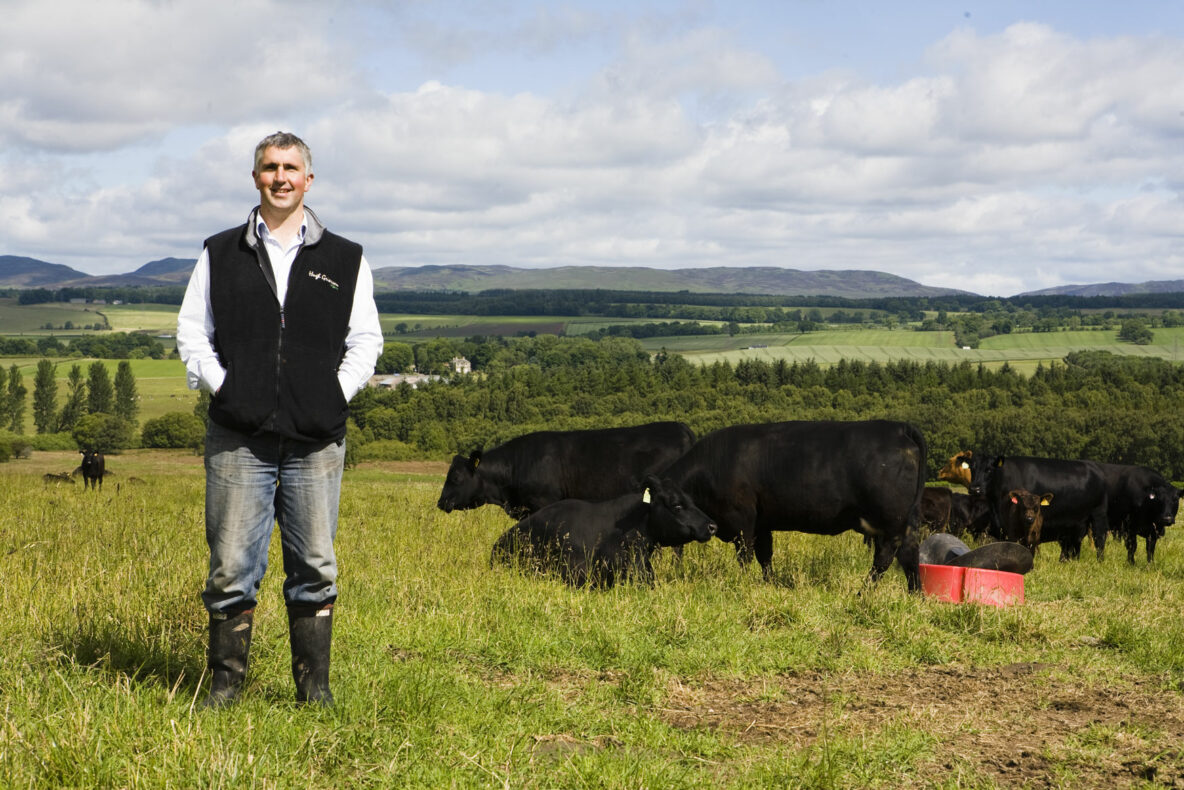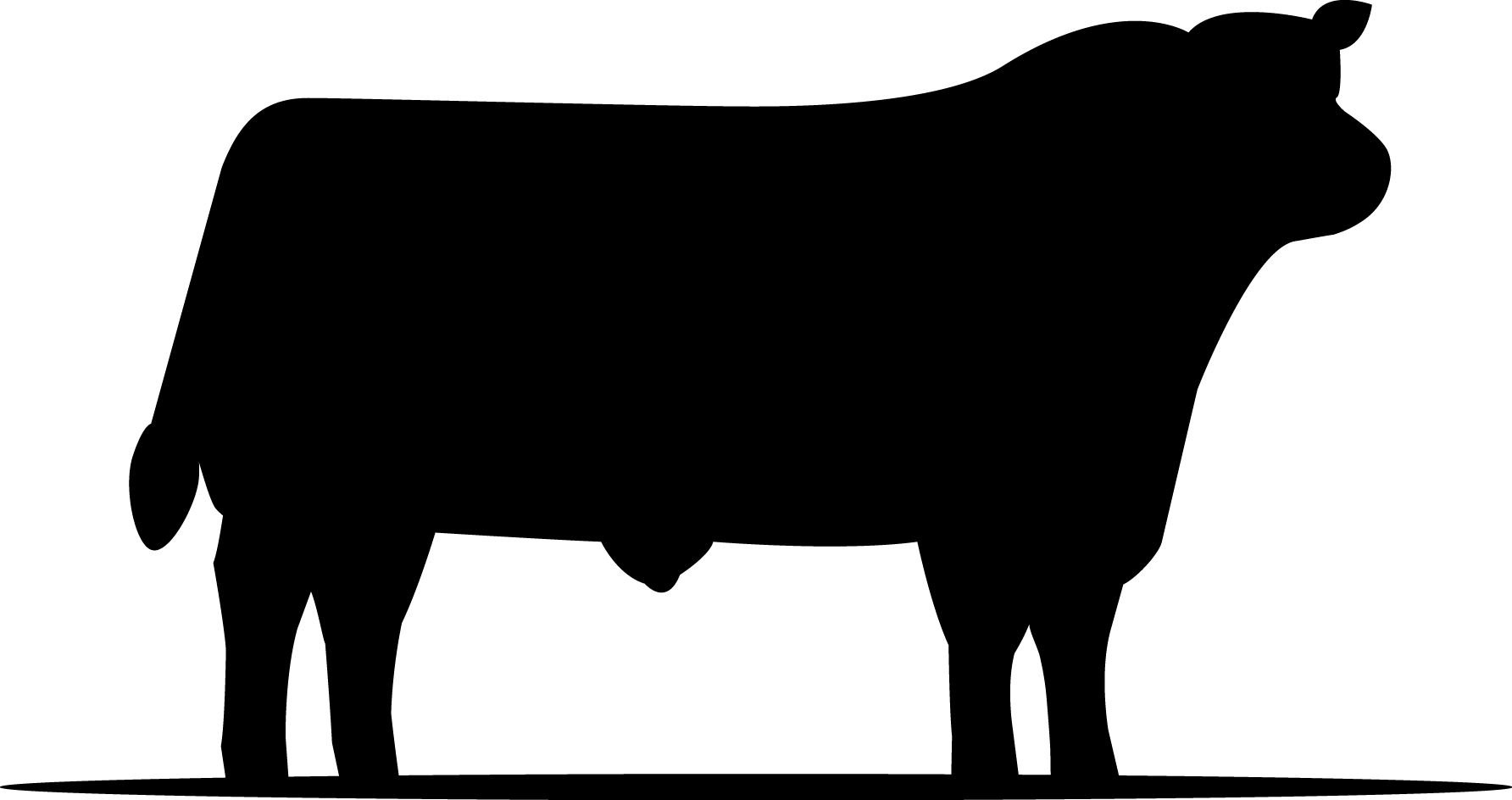Farm facts:
- Newmiln Farm
- 800 acres
- 120 pedigree Aberdeen Angus cows and 400 breeding ewes
- Target KPI’s for the beef system
- Zero assists at calving
- 100% 400kg steer carcasses at 2 years old
- Wintered outdoors on grass & silage diet (no concentrates)
- 650kg target cow size
- 4L carcase with visible marbling in every sirloin steak
Making use of Estimated Breeding Values (EBVs) has been an integral part of Hugh Grierson’s breeding plan to produce a herd of Aberdeen-Angus cattle that both meet the requirements of his butchery business and extensive farming system.
“We’re a mixed farm in the east of Scotland,” Mr Grierson explains. “Alongside the farm business, we have our own butchery, so we’re involved in the entire farm to fork process.
“The farm achieved organic status in 2000 and we are also certified ‘Pasture For Life’. Our cattle and sheep are fed no grains or concentrates, just grass and silage, with herbal leys proving a very useful addition.”
The breed of choice for Mr Grierson is Aberdeen-Angus, chosen for their breeding credentials including:
- Hardiness
- Ability to thrive on grass-fed system
- Calving ease
- Consistent meat-eating quality
- Lower rearing costs while producing tasty, juicy and tender meat
The herd consists of 120 animals who are outwintered and calve mostly in the spring, with 20 calving in September to keep an autumn supply of two-year-old cattle for the butchery.
“Our breeding programme and using EBV’s, has helped us to be selective when it comes to genetics to get that quality and consistency right across our herd. The breed and our organic status are a big selling point for our meat.”
The Griersons retain 20 to 30 heifers each year for breeding, calving them down at 24 months. Poorer quality cows are culled, and 30 of the best animals are served to AI. All animals born are performance tested, using Breedplan. The rest of the cattle are finished and sold through the farm shop.
What is Breedplan?
Based in Australia, Breedplan is a genetic evaluation system used by The Aberdeen-Angus Cattle Society to gauge the potential of animals to show certain traits. It provides the following benefits:
- Based on performance recorded data
- Measured using EBVs
- Provides farmers with data allowing them to select animals best suited to their business and market
“Performance testing through Breedplan isn’t much extra work. We’ve been using the system for 12 years,” says Mr. Grierson. “We measure the weight of new-born calves when they’re caught for tagging, and then weigh them in the autumn and spring. The only extra handling is rounding up the yearlings for ultrasound scanning, but it is well worth it as it provides us with the data to understand the carcase merit of that animal.”
Breedplan is used by Mr Grierson to target annual improvements in whole herd performance rather than producing individually stellar animals.
“My main focus is following the progress of my whole herd and benchmarking,” says Mr. Grierson.
Improving calving ease
One area of focus is calving ease figures, which Mr Grierson believes is the single most important factor in a breeding herd. “If your cows calve easily, you will get more live calves, fewer calves that need help to suckle, and cows that will get back in-calf faster,” he notes. “Cows can also calve outside. All of these areas help lower costs.”
Bull selection on-farm started with choosing sires who had direct calving ease and maternal calving ease scores of +3. As replacement heifers came through with better values, older cows with poorer scores could be culled.
“At one time, before we had Aberdeen-Angus cows, I was assisting nearly 10% of my crossbred cows at calving,” notes Mr Grierson.
“Now after a decade of using EBVs, I haven’t assisted a calving in three years. We don’t have to calve cows; we just drive around tagging calves before they get up and run away!”
What does the consumer want?
With calving ease underpinning the herd’s breeding, Mr Grierson has worked hard to improve the quality of his end product so it’s what consumers want.
“I started with a high intramuscular fat percentage, which determines marbling. However, it is usually linked to the fatness of an animal and excess fat is expensive to produce and results in high wastage in the butchery,” says Mr Grierson.
“So, I now look for bulls which are high in intramuscular fat but also have high retail beef yields. We aim to produce carcases with normal external fat but high marbling. The years of testing and selecting now mean that we deliver reliable, consistent carcases, as required by the butcher, and more importantly, by the consumer.”
Producing beef fit for the future
The environmental impact of red meat production is never far from the industry’s thoughts. Choosing a system and breed that reduces greenhouse gas emissions and is based on forage has aligned Mr Grierson’s farm with this vision.
“Breeding for efficiency and carcase quality enables us to produce meat which meets the consumer’s demands for both taste and sustainability. The Aberdeen-Angus breed fits in with the carbon friendly credentials through utilising naturally grown grass to produce food,” he says
“Our cattle allow us to produce food and protect the environment, and I believe that using ruminants on natural grassland, which can’t be used for anything else, is the way forward.”
The benefits of using Breedplan
Genetic evaluation is key to producing beef fit for the future, according to Robert Gilchrist, CEO of the Aberdeen Angus Society.
“With new payment support regimes coming in and margins getting tighter, beef producers are going to have to explore all avenues to maximise outputs and reduce costs,” he says.
“Breedplan is one of many tools available to farmers and should be considered in tandem with these tools. Data is vital to any farm business now to ensure they can track progress and benchmark performance.
“It’s a great way for farmers to get under the skin of their animals and see what’s actually happening. You could rear two animals that appear exactly the same however they’d have very different performances if their EBVs are different.”
By using EBVs, he says producers can make the best breeding decisions for their business.
“It’s not necessarily about selecting animals which are maximum on all parameters; you need to select for a balanced and productive animal.”
He adds that using EBV’s can help farmers produce an animal that suits the end market, aligning traits with consumer demand, and also marketing beef in a positive way. He stresses that the traits chosen will vary between farms.
“The ideal traits may not be the same on all farms, and there needs to be a balance across traits.
“It’s also important to remember that while EBVs play a big part, management also impacts performance. If an animal is managed incorrectly, then the animal will not reach its optimum potential.”




